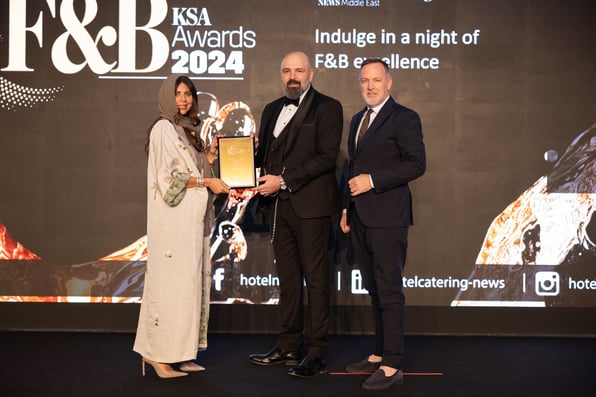7th March 2024
With growing creative expertise in Cairo, TGP International has been expanding its Egypt office, with a team that can deliver exceptional interior design, visualisations, technical drawings, and graphic design services. A key team member of this creative vision is Mohammed Arabi, a Graphic Designer at TGP, who has a talent for creating designs that seamlessly merge Arabic and English, balancing cultural nuance with bold creativity.
From his thoughtful approach to typography to his eye for detail, his work stands out for its ability to connect across audiences. We sat down with Mohammed to learn more about his journey and the craft behind dual-language design.
1. Who is Mohammed Arabi?

I studied architectural engineering at MSA University, where I discovered my passion for visual design. I started by designing for my American football team, MSA Tigers, and later took on freelance projects, exploring how branding influences customer perception.
My career began in the F&B industry, with roles as a Marketing Designer at 30 North Specialty Coffee, Marketing Manager at Gracias Latin American Kitchen, and Digital Marketing Manager at Foodografia. These experiences deepened my understanding of how design shapes both digital and on-ground marketing. I also helped brands like Mizo Drinks and Spinoff Specialty Coffee establish their identities.
Today, I bring this philosophy to TGP International, where I work on large-scale hospitality projects that blend branding, design, and market strategy into cohesive experiences.
2. What key projects stand out for you at TGP?

A key project that stands out for me is designing the logo Icon Mark for Bait Al Safwa.
What made it special wasn’t just the scale or the challenge—it was the opportunity to push creative boundaries while celebrating cultural diversity. Designing for Bait Al Safwa allowed me to blend contemporary aesthetics with cultural authenticity, creating something that felt fresh yet deeply connected to its roots.
3. What’s your creative process like when designing for TGP’s global and multicultural projects?
-4.png?width=3000&height=2000&name=image%20(2)-4.png)
My creative process always begins with research and empathy. To design something meaningful, I need to understand not just the brief but the people behind it—their goals, their audience, and the cultural nuances that need to shine through.
At TGP, where we work with such diverse concepts, this often means diving deep into local cultures while keeping a global perspective in mind.
Once I’ve got that foundation, it’s about experimenting—sketching out ideas, playing with textures, colours, and typography until everything clicks. I also make a point to gather feedback early in the process because collaboration is where magic happens.
By the time a design reaches its final stage, it’s not just my work—it’s a collective effort that represents the heart of TGP.
4. How do you approach dual-language designs, especially balancing Arabic and English?
Dual-language design is about striking the right balance—not just in typography but in representation. It’s about ensuring both languages coexist harmoniously without compromising readability or brand impact.
Bilingual design isn’t just about translating words; it’s about visually translating meaning.
It ensures both languages feel equally intentional to the brand’s identity, creating a design that is both functional and resonant.
5. What role does design play in bringing TGP’s vision to life?
.jpg?width=7360&height=4912&name=KKK_3569%20(1).jpg)
Design at TGP is so much more than just creating something ‘pretty’—it’s about storytelling, connection, and impact. Every design we produce is tied to a bigger vision.
Whether it’s a campaign for a food concept or the branding for a restaurant group, we’re not just decorating a surface; we’re creating an identity, shaping a narrative, and ensuring every detail feels intentional.
Good design is what makes people stop and take notice. Great design is what makes them feel something—and that’s what we strive for at TGP. It’s about leaving an impression that goes beyond the visual, one that stays with the audience long after they’ve walked away.
6. What inspires your work as a designer?
Inspiration is everywhere—it’s in the intricate details of Islamic architecture, the vibrant patterns of street art, or even the shadows cast by sunlight on a quiet morning. Working at TGP, where every project brings a different culture or audience into focus, has been especially inspiring.
But more than anything, what drives me is the challenge of bringing ideas to life.
There’s a special thrill in taking something intangible—an idea, a story, a feeling—and translating it into a visual experience that speaks to people. For me, every blank canvas is an opportunity to create something that resonates on a deeper level.
7. What advice would you give to other designers looking to master bilingual or cross-cultural design?
Bilingual design is like bridging two worlds—it’s both an art and a science. You need to understand the technicalities of working with different scripts (like how Arabic flows right to left) while also appreciating the cultural layers each language brings to the table.
My advice? Always start by understanding your audience. Research not just the language but the context—what do these visuals need to communicate, and who are they speaking to? From there, don’t be afraid to experiment. Pair contrasting elements, test different layouts, and find harmony between the languages.
Above all, be patient with the process. Some of the most creative solutions come from trial, error, and collaboration. And never forget: design isn’t just about aesthetics; it’s about creating a connection.
-1.png?width=3330&height=698&name=TGP%20International%20Logo%20White%20(1)-1.png)



